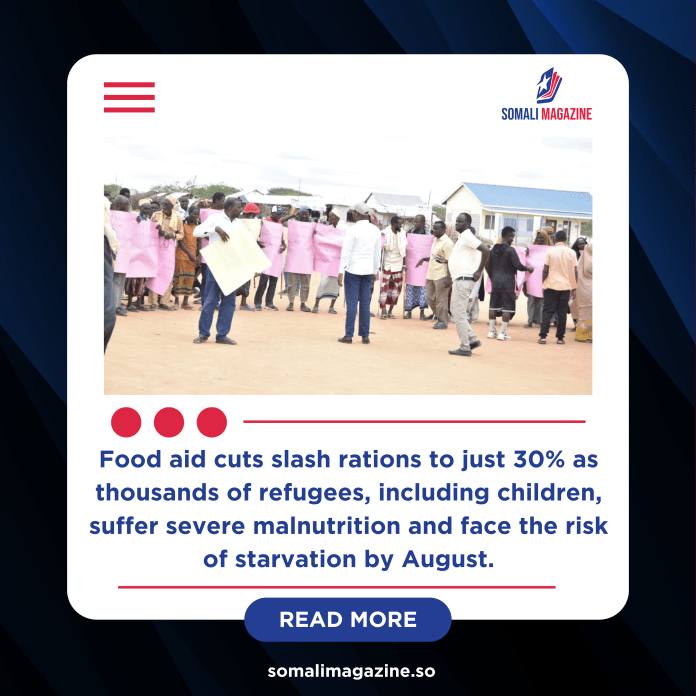Facebook Twitter (X) Instagram Somali Magazine - People's Magazine
Hundreds of thousands of refugees in Kenya’s Kakuma camp are slowly starving after major cuts to US funding forced the United Nations to drastically reduce food aid. The World Food Programme (WFP), which provides food to refugees, says rations have been slashed to just 30% of the minimum needed to stay healthy.
Kakuma camp, located in north-west Kenya, is home to around 300,000 refugees who have escaped conflict and instability in countries like South Sudan, Uganda, and the Democratic Republic of Congo. Many of them now face life-threatening malnutrition due to the lack of food.
At Amusait Hospital in the camp, the impact is heartbreaking. Children suffering from severe malnutrition lie weak and helpless. One baby, Hellen, barely moves. Her skin is peeling and red from malnutrition. Another baby, James, is just nine months old and the eighth child of Agnes Awila, a refugee from northern Uganda.
“The food is not enough,” Agnes says. “My children eat only once a day. If there’s no food, what do you feed them?”
The WFP says the situation worsened after the US, which previously provided around 70% of funding for its Kenya operations, made large cuts earlier this year as part of the “America First” policy. The result has been a massive reduction in food rations and a halt to monthly cash support to families.
Outside the camp’s food distribution centre, refugees wait in long queues under the hot sun. They pass through several checkpoints to collect whatever food is available—usually small amounts of rice, lentils, and cooking oil.
Mukuniwa Bililo Mami, a 51-year-old mother of two who fled conflict in the DR Congo 13 years ago, says the little food she receives now isn’t enough to last a month, let alone the two months it’s supposed to cover. She also used to receive cash transfers, which helped her buy vegetables and other food better suited to her diabetic condition. The cash also helped her start a small business, selling eggs and vegetables in the camp market. But with the cash program now gone, she and many others are struggling.
“The food is not enough and the market is collapsing,” she says.
Small traders like Badaba Ibrahim, who runs a shop in the camp, say business is drying up because people can no longer afford to buy even basic goods. “They tell you, ‘My children haven’t eaten all day,’” he says.
Agnes Livio, a 28-year-old mother of five from South Sudan, lives in a tiny metal cubicle with her children. They now eat just once a day, usually around 2pm. “We used to have porridge for breakfast. Now the children wait until the afternoon for their first meal,” she says.
Back at Amusait Hospital, doctors are feeding malnourished infants through tubes. Though some are discharged after treatment, they are sent back to communities where food is still scarce.
Felix Okech, head of refugee operations at WFP Kenya, says the situation is extremely serious. “If this continues, we are looking at a slowly starving population,” he warns. Some other countries have offered support, but it’s nowhere near enough to make up for the missing US funding.
Without more international help, the outlook is grim. Thousands of children and families in Kakuma camp may face starvation by August if more aid does not arrive soon.
“It’s a really dire situation,” Okech says. “We hope for help, but the prospects are not good

